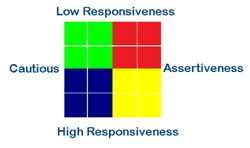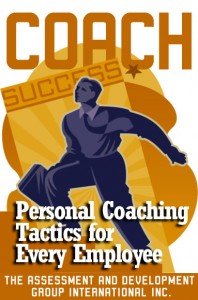Interaction Styles for Developing High Performing Teams and Skilled People-Managers
ADGI licenses the specialized OMS application Interaction Styles at no cost to clients to greatly enhance the value and benefits of OMS. A proprietary variation of the popular Social Styles model of interpersonal communication, Interaction Styles is designed to enable employees to show respect for and manage the behavioral and perceptual differences that are the underlying cause of so many performance problems and issues in the workplace.
The bottom line for employees is greater self control and more mature interactions leading to more frequent positive outcomes. Specifically, the objectives of Interaction Styles are to:
- Create awareness and understanding by helping employees better understand themselves and how their interpersonal styles differ from those of others,
- Improve the communication and functioning of work groups and project teams,
- Sensitize supervisory, sales, and customer service people to the different expectations and styles of those they direct and interact with every day, and
- Help employees manage their relationships more skillfully and have greater success influencing others by demonstrating greater versatility and adaptability.
The Interaction Styles Model
This model is the product of combining the two dimensions of behavior – assertiveness and responsiveness – that appear to have the greatest impact upon interpersonal relationships. By plotting assertiveness on a horizontal axis and responsiveness on a vertical axis, the intersection of the two axes creates a quadrant with four types of interactive behavioral styles. We assign a descriptive name to each of these four representative styles. As the illustration below shows,
1. The combination of high assertiveness and low responsiveness in the upper right quadrant creates a driving, results-centered style, – the Driver;
2. The combination of low assertiveness (cautiousness) and low responsiveness in the upper left quadrant creates an analytical, task-centered style – the Analytical;
3. The combination of high assertiveness and high responsiveness in the lower right quadrant creates an outwardly expressive, people-centered style – the Expressive; and
4. The combination of low assertiveness (cautiousness) and high responsiveness in the lower left quadrant creates an accepting, helpful, people-centered style – the Supportive.
Drivers… Upper Right Quadrant…
Drivers like to be in control in situations, to get things done quickly, and to get them done in their own way. They are competitive people who are more concerned with producing results and accomplishing objectives than with being popular or “liked” by others. Highly independent in their thinking, Drivers hold strong personal opinions on how things should be done, and are not afraid to take a risk and commit themselves to a course of action.
Expressives… Lower Right Quadrant…
Expressives are open, warm, and easily approachable people who like to be actively involved with others. Being competitive, they both enjoy and excel in situations where they are able to use their verbal and social skills to gain acceptance. Very concerned with the process of relating to others and with the quality of their relationships, being popular and being recognized for their accomplishments are very important.
Supportives… Lower Left Quadrant…
Supportives are friendly, helpful, and cooperative people, tolerant and non-critical in their interactions with others. They try to build solid, stable relationships based upon mutual respect and understanding. Wanting to feel that they belong and that they are accepted, Supportives particularly enjoy working with others in a harmonious manner.
Analyticals… Upper Left Quadrant…
Analyticals are very thorough and careful in the manner in which they analyze situations and approach decisions. They enjoy problems which draw upon their analytical skills and which require them to develop conclusions based upon personal investigation. Skeptical of ideas which conflict with their personal experience, they place more weight on their own views than on those of others. Tangible and practical in their thinking, they structure their work around precise facts and hard data whenever possible.
Overcoming Communication Barriers
For many reasons communication is difficult even under the best of circumstances. The major problem all of us experience with our communication is that our manner of relating to other people may cause them some stress and their approaches may have the same effect on us. We like to feel comfortable in our interactions, but when we have to cope with a very different manner of communicating, we get distracted by our own feelings and perceptions, and we build up barriers in one way or another. In some cases we disregard or ignore what others say, we tune out and don’t really listen, we judge rather than really listen, and we try to find fault instead of common ideas we can build upon. And while we are doing this, we are not generally aware that we are doing it!
For instance, Driver personalities, with their impatience and task focus, often get impatient with and place too much pressure upon Supportive personalities, who are more careful, more deliberate, and more cautious with their assertions and opinions. Supportive often perceive Drivers to be heartless machines rather than people.
Analyticals need a lot of factual proof and personal proof before they will change their minds or accept new ideas. Thus they tend to disregard the very general and optimistic statements of the Expressive as “off the wall” ramblings that lack depth or substance. Similarly, Expressives often perceive Analyticals as negative idea killers who don’t want to do anything new or progressive.
Imagine the personal self-esteem, performance, and financial benefits if employees are able to successfully overcome these differences!
Interaction Styles Training
The Interaction Styles license includes rights to use the Interaction Styles training model, content, and materials on an unlimited basis with employees, and incorporates the Interaction Style graph and descriptive report. Client trainers conduct the Interaction Styles session as a stand-alone learning experience for groups of employees or embed it as a module in other developmental programs.
Interaction Guide Reports… Powerful Personal Productivity Tools
Developed from our popular Apple iPhone™ applications, SuperSell, Coach, and Interact, three Interaction Guide reports are valuable personal productivity tools that can help every manager more successfully and effectively manage, motivate and communicate with employees and team members. Developed by ADGI and using the Interaction Styles behavioral model, these unique proprietary tools generate strategies and tactics specific to the personalities of a manager and each of his or her employees. Here’s what these three interaction reports can do for you:
Interact… How to Engage and Retain Talented Employees and Staff
The purpose of Interact is to help you improve the performance and productivity of your employee team and retain valuable employees by aligning them with jobs that best utilize their talents and providing more appropriate personal management that is most responsive to their needs.
Interact will enable you to build higher performance by providing you with detailed insights into the motivation, the talents, and the behaviors of each employee, and giving you the management strategy and tactics tailored to each employee’s style.
As a manager you control the most important factors influencing employee commitment and effective employee behaviors, which together we call employee engagement. You also exercise great power in retaining talented employees. Management training tends to stereotype much of what managers do and does not generally address the variances in individual styles and needs or the situational dynamics occurring when the personalities of the manager and the employee connect. Interact is a productivity tool that will help you create the best work environment and management strategy for each employee and ensure that each person has the opportunity to make full use of his or her talents. Together these add up to more active engagement and higher retention.
Coach… How to Become a Highly Effective Management Coach
The purpose of Coach is to help you improve the performance and productivity of your employee team by helping you be a more effective management coach.
Coach will enable you to leverage your coaching interactions into higher performance by providing you with detailed insights into the motivation, the talents, and the behaviors of each employee, and giving you the coaching strategy and tactics tailored to each employee’s style.
Coaching employees is one of the most challenging management tasks. Although coaching is a general expectation today for almost all managers, the “one size fits all” training that managers receive, if they do in fact receive any, does not take into account the situational dynamics occurring when the personalities or “styles” of the manager and the employee meet up in a coaching interaction. Coach is a productivity tool that will help you best apply your talents to the coaching process and deliver coaching guidance in the optimal way for each employee.
SuperSell… How You Can Sell Ideas and Influence More Successfully
The purpose of SuperSell is to help you sell your ideas and influence the actions and decisions of other people more skillfully.
SuperSell will enable you to achieve better outcomes in your efforts to influence others by providing you with detailed insights into the motivation, the preferences, and the behaviors of each “buyer”, and giving you the selling strategy and tactics tailored to each person’s style.
Good ideas even with the best of intent are not necessarily easy sells and certainly don’t always sell themselves! Effectively selling your ideas to others can come off the rails if you fail to manage the “buyer”: fail to respond to the person’s needs appropriately or fail to show respect for and adapt to the person’s worldview and manner of communicating. SuperSell is a productivity tool that can help you use and adapt your personal talents to the communication approach that will work best for each person.
 Recent studies on the effectiveness of coaching are pretty consistent in telling us that recipients perceive some benefit, but it’s limited, and managers continue to struggle with the process. The same studies also note that these findings are neither unexpected nor surprising when compared to other management interactions.
Recent studies on the effectiveness of coaching are pretty consistent in telling us that recipients perceive some benefit, but it’s limited, and managers continue to struggle with the process. The same studies also note that these findings are neither unexpected nor surprising when compared to other management interactions.

